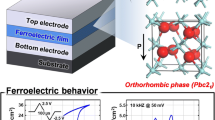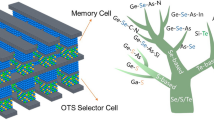Abstract
Nitrogen-doped Ge2Sb2Te5 (GST) films for nonvolatile memories were prepared by reactive sputtering with a GST alloy target. Doped nitrogen content was determined by using x-ray photoelectron spectroscopy (XPS). The crystallization behavior of the films was investigated by analyzing x-ray diffraction (XRD) and differential scanning calorimetry (DSC). Results show that nitrogen doping increases crystallization temperature, crystallization-activation energy, and phase transformation temperature from fcc to hexagonal (hex) structure. Doped nitrogen probably exists in the grain vacancies or grain boundaries and suppresses grain growth. The electrical properties of the films were studied by analyzing the optical band gap and the dependence of the resistivity on the annealing temperature. The optical band gap of the nitrogen-doped GST film is slightly larger than that of the pure GST film. Energy band theory is used to analyze the effect of doped nitrogen on electrical properties of GST films. Studies reveal that nitrogen doping increases resistivity and produces three relatively stable resistivity states in the plot of resistivity versus annealing temperature, which makes GST-based multilevel storage possible. Current-voltage (I-V) characteristics of the devices show that nitrogen doping increases the memory’s dynamic resistance, which reduces writing current from milliampere to microampere.
Similar content being viewed by others
References
B. Qiao, Y. Lai, J. Feng, Y. Ling, Y. Lin, T. Tang, B. Cai, and B. Chen, J. Mater. Sci. Technol. 21, 95 (2005).
Y.N. Hwang et al., IEDM Tech. Dig. 893 (2003).
S. Lai, IEDM Tech. Dig. 255 (2003).
T.H. Jeong, M.R. Kim, H. Seo, J.W. Park, and C. Yeon, Jpn J. Appl. Phys. 39, 2775 (2000).
R. Kojima, S. Okabayashi, T. Kashihara, K. Horai, T. Matsunaga, E. Ohno, N. Yamada, and T. Ohta, Jpn. J. Appl. Phys. 37, 2098 (1998).
S.J. Kim, H. Seo, and M.R. Kim, Jpn. J. Appl. Phys. 38, 1713 (1999).
H. Seo, T.H. Jeong, J.W. Park, C. Yeon, S.J. Kim, and S.Y. Kim, Jpn. J. Appl. Phys. 39, 745 (2000).
S. Kyrsta, R. Cremer, D. Neuschutz, M. Laurenzis, P.H. Bolivar, and H. Kurz, Appl. Surf. Sci. 55, 179 (2001).
H.E. Kissinger, Anal. Chem. 29, 1702 (1957).
I.I. Petrov, R.M. Imamov, and Z.G. Pinsker, Sov. Phys. Crystallogr. 13, 339 (1968).
N. Yamada and T. Matsunaga, J. Appl. Phys. 88, 7020 (2000).
T. Nonaka, G. Ohbayashi, Y. Toriumi, Y. Mori, and H. Hashimoto, Thin Solid Films 370, 258 (2000).
N. Yamada, MRS Bull. 21, 48 (1996).
R. Kojima, T. Kouzaki, T. Matsunaga, and N. Yamada, Proc. SPIE Int. Soc. Opt. Eng. 3401, 14 (1998).
H.B. Yao, L.P. Shi, T.C. Chong, P.K. Tan, and X.S. Miao, Jpn J. Appl. Phys. 42, 828 (2003).
M. Kastner, Phys. Rev. B 7, 5237 (1973).
H. Hoffmann, Festkor. A. S. 22, 255 (1982).
M. Kastner, D. Adler, and H. Fritzsche, Phys. Rev. Lett. 37, 1504 (1976).
A. Pirovano, A.L. Lacaita, F. Pellizzer, S.A. Kostylev, and A. Benvenuti, IEEE. T. Electron. Dev. 51, 714 (2004).
S.R. Ovshinsky and W. Czubatyj, Proc. SPIE Int. Soc. Opt. Eng. 4085, 15 (2001).
Author information
Authors and Affiliations
Rights and permissions
About this article
Cite this article
Lai, Y., Qiao, B., Feng, J. et al. Nitrogen-doped Ge2Sb2Te5 films for nonvolatile memory. J. Electron. Mater. 34, 176–181 (2005). https://doi.org/10.1007/s11664-005-0230-2
Received:
Accepted:
Issue Date:
DOI: https://doi.org/10.1007/s11664-005-0230-2




